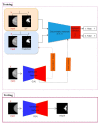Fully Automated Breast Density Segmentation and Classification Using Deep Learning
- PMID: 33238512
- PMCID: PMC7700286
- DOI: 10.3390/diagnostics10110988
Fully Automated Breast Density Segmentation and Classification Using Deep Learning
Abstract
Breast density estimation with visual evaluation is still challenging due to low contrast and significant fluctuations in the mammograms' fatty tissue background. The primary key to breast density classification is to detect the dense tissues in the mammographic images correctly. Many methods have been proposed for breast density estimation; nevertheless, most of them are not fully automated. Besides, they have been badly affected by low signal-to-noise ratio and variability of density in appearance and texture. This study intends to develop a fully automated and digitalized breast tissue segmentation and classification using advanced deep learning techniques. The conditional Generative Adversarial Networks (cGAN) network is applied to segment the dense tissues in mammograms. To have a complete system for breast density classification, we propose a Convolutional Neural Network (CNN) to classify mammograms based on the standardization of Breast Imaging-Reporting and Data System (BI-RADS). The classification network is fed by the segmented masks of dense tissues generated by the cGAN network. For screening mammography, 410 images of 115 patients from the INbreast dataset were used. The proposed framework can segment the dense regions with an accuracy, Dice coefficient, Jaccard index of 98%, 88%, and 78%, respectively. Furthermore, we obtained precision, sensitivity, and specificity of 97.85%, 97.85%, and 99.28%, respectively, for breast density classification. This study's findings are promising and show that the proposed deep learning-based techniques can produce a clinically useful computer-aided tool for breast density analysis by digital mammography.
Keywords: breast cancer; breast density; convolutional neural network; deep learning; generative adversarial networks; mammograms.
Conflict of interest statement
The authors declare no conflict of interest.
Figures







References
-
- Abdel-Nasser M., Rashwan H.A., Puig D., Moreno A. Analysis of tissue abnormality and breast density in mammographic images using a uniform local directional pattern. Expert Syst. Appl. 2015;42:9499–9511.
-
- Abbas Q. DeepCAD: A computer-aided diagnosis system for mammographic masses using deep invariant features. Computers. 2016;5:28.
-
- Sprague B.L., Stout N.K., Schechter C., Van Ravesteyn N.T., Cevik M., Alagoz O., Lee C.I., Van Den Broek J.J., Miglioretti D.L., Mandelblatt J.S., et al. Benefits, harms, and cost-effectiveness of supplemental ultrasonography screening for women with dense breasts. Ann. Intern. Med. 2015;162:157–166. - PMC - PubMed
Grants and funding
LinkOut - more resources
Full Text Sources

